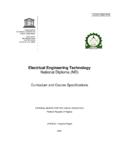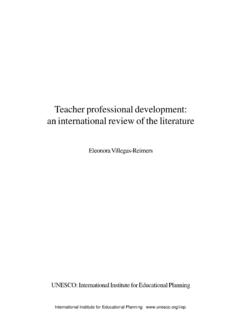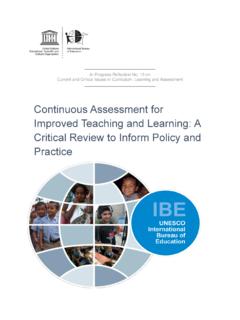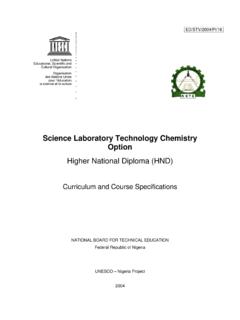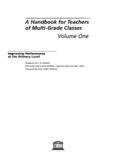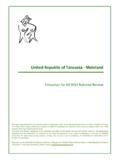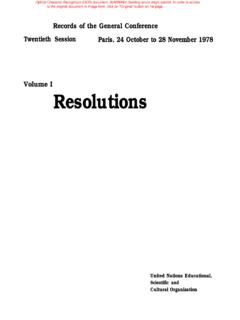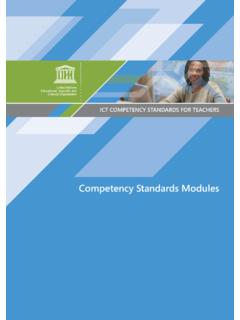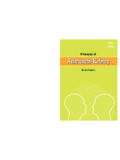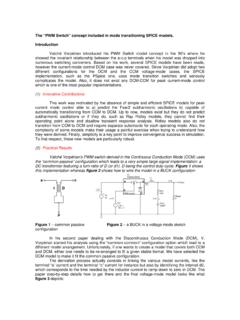Transcription of Introduction to education project planning and management ...
1 Educational planning and management in the Earthquake affected AreasUnited Nations Educational, Scientific and Cultural OrganizationOrganisation des Nations Unies pour l ducation, la science et la culture Trainer s NotesIntroduction to education project planning and ManagementWorkshop for Senior ManagersDirectorate of education Extension, AJKM onitorEvaluatePlan, DesignRedesignAssessImplementAnalyseDisa sterMonitorEvaluatePlan, DesignRedesignAssessImplementAnalyseDisa ster The Directorate of education Extension, AJK and UNESCO gratefully acknowledge the support of the Department for International Development (DFID) and the Government of Japan in the production of this material.
2 Educational planning and management in the Earthquake affected Areas: Introduction to education project planning and management Trainer s Notes UNESCO/DEE 1 Table of Contents Note to the 2 4 Session : Workshop Opening and Welcome .. 6 Session : Introduction and Objectives .. 7 Session : Introduction to education project cycle management .. 8 Session : Using SWOT 14 Session : SWOT analysis: practical exercise .. 18 Day 1 20 Session : The Learning System .. 21 Session : Practical steps in ensuring a rights-based approach.
3 28 Session : Quality education .. 32 Session : Dimensions of Educational Quality .. 38 Day 2 40 Session : Introduction to Logical Framework Approach .. 42 Session : Problem Tree Analysis .. 45 Session : Problem Trees and Objective Trees .. 49 Session : Setting SMART 53 Session : Introduction to Logical Framework 56 Day 3 59 Session : LogFrame Exercise, II .. 62 Session : LogFrame Exercise, III .. 66 Session : Presentation of project proposals and workshop closing .. 68 Educational planning and management in the Earthquake affected Areas: Introduction to education project planning and management Trainer s Notes UNESCO/DEE 2 Note to the trainers How was this guide developed?
4 This manual has been designed in response to the needs identified by senior education officials in the earthquake- affected areas of NWFP and AJK. The objective of the workshop is to strengthen the management skills of senior-level managers, especially with regard to the project cycle and the Logical Framework Approach. The workshop is based on an inter-active approach, which follows the essential principles of adult learning and models the type of approach that is necessary for teachers and managers to use with students in order to build a stronger and more effective education programme following the tragedy of the earthquake. The workshop uses a variety of approaches and active learning to ensure that participants can internalise what they are learning.
5 It is also designed to be practical and give participants tools that they can use effectively in their work. How is this guide organised? There are two books: the Trainer s Notes for the person doing the training and the Workbook for those being trained. The master trainer needs to read these books very thoroughly. Trainer s notes The trainer s notes consist of: Session plans: These explain the objectives, the time allocated for the session (although this can only be a guide) and directions for the activities. To conduct this training effectively, trainers need to familiarize themselves with the content of each session before conducting it. Materials required: In addition to the basic materials that are necessary for the running and implementation of this course (see below), each session includes a list of items that are specifically required in order to run the session effectively.
6 The trainer should make sure that all of these materials are prepared in advance of the session. Activities are designed to be undertaken as they are written. All instructions are provided to the trainer and time allocations are listed both in the trainer s note and also in the Workbook for the actual activity. Tables, questions, case studies, role play scenarios and extra space for notes are all laid out in the Workbook. Where sample responses are included in the training guide, possible responses (or responses to be added) are included in the text. Workbook The Workbook is designed as a take-home reference for the participant. Encourage participants to record all their notes and responses to activities in Educational planning and management in the Earthquake affected Areas: Introduction to education project planning and management Trainer s Notes UNESCO/DEE 3 their Workbook.
7 All tables, questions and scenarios everything the participant needs to be able to complete the exercise is in the Workbook. The Workbook also includes reference materials which the trainer should read and familiarize him/herself with in advance of conducting the training. Materials needed for this course Each session plan contains a list of materials that are specifically needed for each session. In addition, the following materials are required for all sessions: Flipchart paper (at least 100 white sheets) Tape or yellow tack to post flip charts on the wall or cards on charts Permanent markers (at least 24) Pens, pencils and erasers for participants Index cards or post-it notes (pieces of paper that are sticky on the back); if these are not available heavy stock paper can be cut into pieces that are approximately 10 x 15 centimetres each.
8 You will need approximately 300 of these. Balloons (approximately 30) Crayons (approximately 200 in various colours) In addition, this course has been developed with a series of PowerPoint presentations. If you have a data projector and laptop available, you can use these presentations. If you do not have a data projector and laptop, you can print the PowerPoint slides on overhead transparencies for use with an overhead projector. If you do not have an overhead projector, you should transfer key points or illustrations from the slides onto flipchart paper for use during the sessions. Basic Training Tips While it is assumed that the course facilitators are experienced trainers, it would still be useful to review the basic training tips that are included in both the middle-managers course Quality Educational Response and the teacher training course for teachers affected by the earthquake.
9 These basic training tips are a helpful reminder to even the most experienced trainers. Educational planning and management in the Earthquake affected Areas: Introduction to education project planning and management Trainer s Notes UNESCO/DEE 4 Agenda Time Session/Activity Key Learning Points/Themes DAY 1 8:30-9:00 Registration 9:00-10:00 Workshop Opening and Welcome Opening of the workshop Welcome UNESCO s support in the earthquake- affected districts and the context for this workshop 10:00-10:30 Tea break 10:30-11.
10 00 Introduction and Objectives Workshop objectives and agenda shared Participants introduced to one another 11:00-13:00 Introduction to education project cycle management Steps in the project cycle Contextual analysis: effects of the earthquake on education in the affected districts 13:00-14:00 Lunch 14:00-14:45 Using SWOT analysis Introduction to the SWOT analysis tool Practice using SWOT with an example Identification of educational problems in the earthquake- affected areas that can be analysed using SWOT 14:45-15:00 Tea break 15:00-16:30 SWOT analysis: practical exercise Practice using SWOT analysis based on identified problems of access and quality in the earthquake- affected areas Identification of strategies based on the SWOT analysis 16:30 Adjourn DAY 2 8:30-9:00 Day 1 Review 9:00-10:30 The Learning System The various components of the learning system and how they are inter-related The relationship between the learner, the teaching/learning system, the education sectors and the environment The link between values and rights and how values are reflected in the learning system 10:30-11:00 Tea break 11:00-13.
